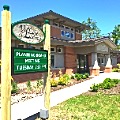- By Dan Veaner
- News
 Print
Print  The Village of Lansing Trustees approved a new Commercial Medium Traffic District in its zoning law Monday, in a unanimous vote. Mayor Donald Hartill says the Village has contemplated the zoning change for over a decade, and Planning Board Chairman Mario Tomei says that it took two years to develop the law in its final form.
The Village of Lansing Trustees approved a new Commercial Medium Traffic District in its zoning law Monday, in a unanimous vote. Mayor Donald Hartill says the Village has contemplated the zoning change for over a decade, and Planning Board Chairman Mario Tomei says that it took two years to develop the law in its final form."The Village Planning Board and the Board of Trustees had been considering talking about the changes," said Village Attorney David Dubow. "That was part of the Comprehensive Plan, which forced the boards to look at the Village to see what it used to look like, what it looks like today, and more importantly what you may think the Village should be like in the next 20 or 30 years. That was the catalyst for doing that."
The law creates a new Commercial Medium Traffic District (CMT) will be created from part of the existing Commercial Low Traffic District (CLT) within the area near the malls and the YMCA. Under the new zoning, some of the existing uses in the CLT will be removed. Some of those uses are Hospitals and clinics, low traffic food and beverage establishments, group residential buildings, construction sales and storage. The new law also adds new and revised uses to the CLT District, such as Temporary non-commercial activities, employee cafeteria food and beverage services, special care facilities, and assisted living facilities. This does not necessarily mean these will pop up in the CLT area that remains -- just that they are now allowed.
"The other thing that motivated this is that most of that property has remained vacant for a long time," Hartill said. "The reason is that the market for those kind of activities that are permitted in Low Traffic Commercial zones is saturated. There is no motivation to try to change that, so we felt it was appropriate to reconsider by modifying it slightly to permit Medium Traffic uses, which is the result of this local law. It's been a long time coming."
That will mean taking land that has been underused in the busiest area of the Village, and creating a more gradual buffer between the Commercial High Traffic District that includes the malls and surrounding residential areas.
Permitted use with no additional approval will include underground utility service, natural parks, alteration to building or improved site with no change in use and no change in applicable parking space requirements, and temporary non-commercial activities. A list of uses are subject either to additional conditions or a special permit. The latter uses include utility transmission/storage/plants, religious facilities, schools, indoor recreation/clubs, offices/studios/services, government buildings, museums/public buildings, clinic, small scale sales, low traffic food and beverage establishments, alterations to buildings or improved sites that result in a change in use or a change in applicable parking space requirements, low impact technology uses, and bank administrative operations.
"Developers, some of which we know of, some we may not know of, may have some interest in that," Dubow said. "The purpose of it was to enable some uses that are now more appropriate for the Village in this kind of 'downtown' area, and to make sure that some of the residential areas around that are protected a bit better."
v12i5



